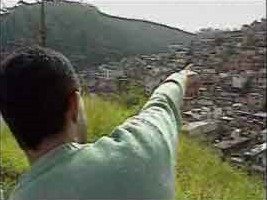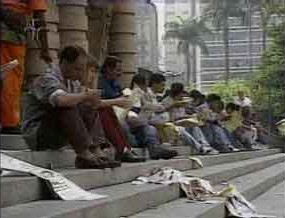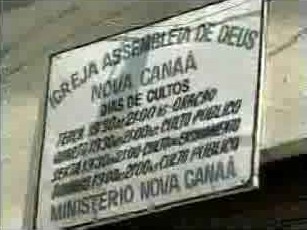DOSSIÊ PERIFERIA

The series Dossiê Periferia (Periphery Dossier) was aired on TV Cultura in 2005. Produced through a partnership between the broadcasting station, CEM and the Seade Foundation, the episodes in the video series present social, economic and cultural aspects of Greater Sao Paulo in accordance with research carried out by the Center for Metropolitan Studies (CEM) and Seade Foundation.
The features are broadcasted on Jornal da Cultura from Monday through Saturday at 9:00 p.m.
- Staff: Mônica Teixeira (reporter and director) and Leandro Hernandez (producer).
- Staff CEM: Tatiana Lotierzo
VIDEOS:
The Periphery, beyond the space
 The first episode of the series seeks a definition for the word ‘periphery’ in the Brazilian context: is the periphery simply what is separated from central areas? Is it a word equivalent to poor areas? The report accompanies the sociologist Eduardo Marques to Vila Areião in the metropolitan area of Sao Paulo - referred to as ABC - and shows the conclusions that the CEM researchers reach from the group of studies: those populations, within the same level of income, live better or worse social conditions depending on the location in which they live
The first episode of the series seeks a definition for the word ‘periphery’ in the Brazilian context: is the periphery simply what is separated from central areas? Is it a word equivalent to poor areas? The report accompanies the sociologist Eduardo Marques to Vila Areião in the metropolitan area of Sao Paulo - referred to as ABC - and shows the conclusions that the CEM researchers reach from the group of studies: those populations, within the same level of income, live better or worse social conditions depending on the location in which they live
See the video report: The Periphery, beyond the space
Poverty, a heterogeneous phenomenon
 Poverty is not homogenous and assumes different forms according to a series of factors. This time, the report from TV Cultura accompanies the researcher Tiaraju D'Andrea to the neighborhoods of Paraisópolis and Vila Nova Esperança showing the differences between types of poverty in the two regions. In the shantytown of Paraisopolis, the residents live better. The majority of the residents are employed, largely because this region is closer to the wealthier areas of the metropolis. It has urban infrastructure and NGOs are active there. In Vila Nova Esperança, which is more isolated geographically from the wealthier areas, many stop working because of the distance. They have limited access to light, water and a lack of attention from the public and third sectors.
Poverty is not homogenous and assumes different forms according to a series of factors. This time, the report from TV Cultura accompanies the researcher Tiaraju D'Andrea to the neighborhoods of Paraisópolis and Vila Nova Esperança showing the differences between types of poverty in the two regions. In the shantytown of Paraisopolis, the residents live better. The majority of the residents are employed, largely because this region is closer to the wealthier areas of the metropolis. It has urban infrastructure and NGOs are active there. In Vila Nova Esperança, which is more isolated geographically from the wealthier areas, many stop working because of the distance. They have limited access to light, water and a lack of attention from the public and third sectors.
See the video report: Poverty, a heterogeneous phenomenon
Research, Transference, Dissemination
 After accompanying CEM researchers to locations on the periphery of Sao Paulo, the third installment of video reports shows the work routine of the researchers. Between fieldwork, seminars, book publications, development of databases and other activities, the almost 30 researchers go to any length to understand how the metropolis functions.
After accompanying CEM researchers to locations on the periphery of Sao Paulo, the third installment of video reports shows the work routine of the researchers. Between fieldwork, seminars, book publications, development of databases and other activities, the almost 30 researchers go to any length to understand how the metropolis functions.
See the video report: Research, Transference, Dissemination
The New Shapes of Unemployment
 Unemployment is a part of Brazilian life. If in the 1980’s in Sao Paulo, the rates of unemployment hung around 10%, between the periods of crisis and economic recovery, in the 1990’s the rate of unemployment reached 20% and stagnated. For the researcher Nadya Araújo Guimarães, there was a change in the look of the labor market. There are greater transitions between occupations, rising informal employment and some groups have become more vulnerable to unemployment including the youngest and the oldest.
Unemployment is a part of Brazilian life. If in the 1980’s in Sao Paulo, the rates of unemployment hung around 10%, between the periods of crisis and economic recovery, in the 1990’s the rate of unemployment reached 20% and stagnated. For the researcher Nadya Araújo Guimarães, there was a change in the look of the labor market. There are greater transitions between occupations, rising informal employment and some groups have become more vulnerable to unemployment including the youngest and the oldest.
See the video report: The New Shapes of Unemployment
Faith in Motion
 It is not only the labor market that is in intense movement. Religion is also increasingly less institutionalized and more individualized, in particular in the poorest areas. This report accompanies anthropologist Ronaldo de Almeida to Chácara Bananal, on the border between Sao Paulo and Embu, and takes a look at the transformation in the field of religion occurring in the last 30 years. He shows the massive circulation of followers between churches and changes in the ways of believing in God.
It is not only the labor market that is in intense movement. Religion is also increasingly less institutionalized and more individualized, in particular in the poorest areas. This report accompanies anthropologist Ronaldo de Almeida to Chácara Bananal, on the border between Sao Paulo and Embu, and takes a look at the transformation in the field of religion occurring in the last 30 years. He shows the massive circulation of followers between churches and changes in the ways of believing in God.
See the video report: Faith in Motion (A Fé em Movimento)



